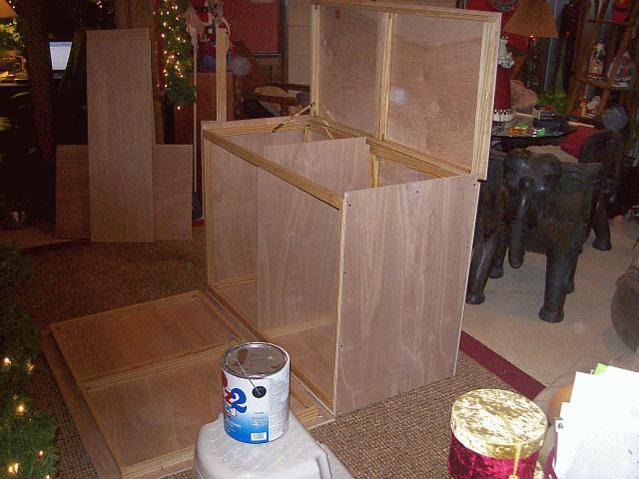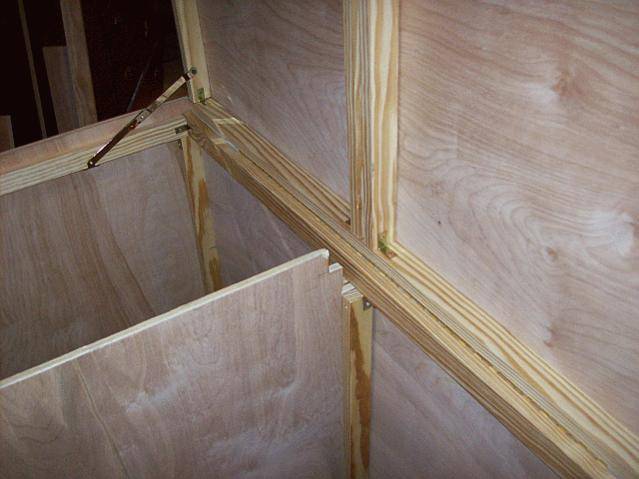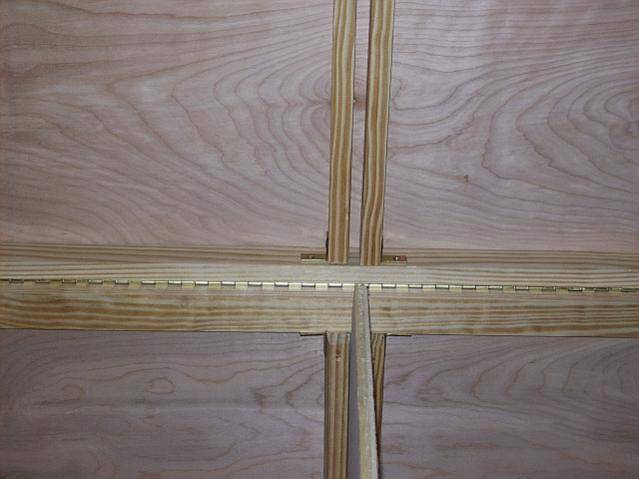I did this grow last year and I am building out a new cabinet right now and will christen it with the Russian Roulette.
Russian Roulette
Genetic Predisposition: Mostly Sativa influences.
Strain Lineage: AK47 x Romulan (backcross to White Rhino)
Flowering Period: 50 - 65 Days (higher the temps, the shorter photo period)
Yield: 50 to 125 grams (finished/dry weight) per plant @ 35 watts/SF
Potency: 10 (if there is stronger out there, I feel for whoever has to smoke it)
Medical Efficacy: chain the fridge, power slam buzz, good for pain relief, but not restful. Head buzz with major disruption of coordination. Moderate tolerance build-up. Overdose danger.
System: 4-station DWC using Lucas Formula Nutes. 30-day Veg/58-65 Day Bloom. Moderate Feeder. Care in Veg.
Background
This strain came to me from a friend on OG who, like me, was/is a medical grower. My chief complaint is migraine pain. I'm a chronic pain patient (daily-daily) so I need something that hits hard and stands up to tolerance issues. My friend sent me a taste along with some seeds. No warnings, no hints towards moderation. Just some bud and some seeds in a small seed bag. He claimed it was AK47 by Romulan, but admitted that prescription drug abuse and heavy duty doses of this pot had clouded his judgment and made memory a rather dicey proposition. I took it on face value that he was just another lightweight, a punk who thought he knew what old school pot was all about. My contempt overflowed and I blew him off.
Then I smoked the pot.
Have you ever been sick - as in puking sick - and knew it was coming and there was nothing to be done about it? You just knew that sometime in the next hour you were going to be hurling your guts out? I took the time to clean the bowl in the bathroom and get some comfortable pillows and towels so the ordeal would not be any more than it had to be.
I took four hits. Just four lung fulls of eye-popping poison that went right to my brain and obliterated all thoughts other than the fact I would be sick and that was exceedingly funny. I was about to die and yet it was so funny I couldn't help myself from laughing at my sorry condition. And so it went. I threw up for an hour and was too stoned to fall asleep so I had to ride it out over the next four hours.
This is what happens when you decide to purge your system of cannabis and clean everything out, then go smoke weed...
To say this was the most powerful weed I have ever smoked would be like saying Mt. Everest was a good-sized hill.
Since then, I ended up with some feminized seeds and I think it was accidentally crossed with some White Rhino I was growing at the same time. Oh well, it makes a nice smoke.
That's the story, so let's turn the page.
+++++++++++++++++++++++++++++++++++++++++++++++++
The Construction Program
The focal point of this thread is the construction of the ultimate stealth grow cabinet - one designed to look exactly like a chest of drawers, but with a fold-down front and top that flips open.
Basic Cabinet Shell...
[IMGhttp://www.icmag.com/ic/picture.php?albumid=11968&pictureid=238874[/IMG]
The cabinet is under construction. I've built the shell and painted out the inside (note photos). The cabinet measures 4-'0" wide by 2'-0" deep by 3-'0" high. As you can see from the photos, it has a fold-down front and a flip-open top. When the cabinet is done, the top will close down over the top lip of the fold-down front and provide a seal. All seals have been doubled so there will be no air leaks, no light leaks and no sound leaks.
Cabinet Opposite Angle...

I'll be doing lights tomorrow and then the extraction system. The bloom chamber is roughly 4 square feet of space with an inside headspace of 30", so I will be looking at plants with buds in the 20" if I do the SCROG approach. This is designed to have a pull-out "SCROG module" that slides in and out to allow for plant maintenance (right side). The lighting will consist of six (6) 42-watt CFLs, giving me around 65 watts/SF of bloom sunshine.
Joint Detail - Note Double-Lapped Joints Construction...

The left side is the mom area and veg area. I may add a cloner, but I like things simple, so I will probably just use a drink cup of H2O and let nature take its course on cloning. Veg area will have two (2) 26-watt CFLs to give me some really good sunshine. The wall on the left side of the box will provide (hopefully!) space for no less than four (4) moms. The final area within the left side will include the ventilation unit (175 cfm Vortex fan and 4" air filter) in a felt lined box to make sure noise is eliminated.
Hinge Detail Photo - Note Piano Hinge...

That's the starting point. Let's see where it all goes...
Russian Roulette
Genetic Predisposition: Mostly Sativa influences.
Strain Lineage: AK47 x Romulan (backcross to White Rhino)
Flowering Period: 50 - 65 Days (higher the temps, the shorter photo period)
Yield: 50 to 125 grams (finished/dry weight) per plant @ 35 watts/SF
Potency: 10 (if there is stronger out there, I feel for whoever has to smoke it)
Medical Efficacy: chain the fridge, power slam buzz, good for pain relief, but not restful. Head buzz with major disruption of coordination. Moderate tolerance build-up. Overdose danger.
System: 4-station DWC using Lucas Formula Nutes. 30-day Veg/58-65 Day Bloom. Moderate Feeder. Care in Veg.
Background
This strain came to me from a friend on OG who, like me, was/is a medical grower. My chief complaint is migraine pain. I'm a chronic pain patient (daily-daily) so I need something that hits hard and stands up to tolerance issues. My friend sent me a taste along with some seeds. No warnings, no hints towards moderation. Just some bud and some seeds in a small seed bag. He claimed it was AK47 by Romulan, but admitted that prescription drug abuse and heavy duty doses of this pot had clouded his judgment and made memory a rather dicey proposition. I took it on face value that he was just another lightweight, a punk who thought he knew what old school pot was all about. My contempt overflowed and I blew him off.
Then I smoked the pot.
Have you ever been sick - as in puking sick - and knew it was coming and there was nothing to be done about it? You just knew that sometime in the next hour you were going to be hurling your guts out? I took the time to clean the bowl in the bathroom and get some comfortable pillows and towels so the ordeal would not be any more than it had to be.
I took four hits. Just four lung fulls of eye-popping poison that went right to my brain and obliterated all thoughts other than the fact I would be sick and that was exceedingly funny. I was about to die and yet it was so funny I couldn't help myself from laughing at my sorry condition. And so it went. I threw up for an hour and was too stoned to fall asleep so I had to ride it out over the next four hours.
This is what happens when you decide to purge your system of cannabis and clean everything out, then go smoke weed...
To say this was the most powerful weed I have ever smoked would be like saying Mt. Everest was a good-sized hill.
Since then, I ended up with some feminized seeds and I think it was accidentally crossed with some White Rhino I was growing at the same time. Oh well, it makes a nice smoke.
That's the story, so let's turn the page.
+++++++++++++++++++++++++++++++++++++++++++++++++
The Construction Program
The focal point of this thread is the construction of the ultimate stealth grow cabinet - one designed to look exactly like a chest of drawers, but with a fold-down front and top that flips open.
Basic Cabinet Shell...
[IMGhttp://www.icmag.com/ic/picture.php?albumid=11968&pictureid=238874[/IMG]
The cabinet is under construction. I've built the shell and painted out the inside (note photos). The cabinet measures 4-'0" wide by 2'-0" deep by 3-'0" high. As you can see from the photos, it has a fold-down front and a flip-open top. When the cabinet is done, the top will close down over the top lip of the fold-down front and provide a seal. All seals have been doubled so there will be no air leaks, no light leaks and no sound leaks.
Cabinet Opposite Angle...
I'll be doing lights tomorrow and then the extraction system. The bloom chamber is roughly 4 square feet of space with an inside headspace of 30", so I will be looking at plants with buds in the 20" if I do the SCROG approach. This is designed to have a pull-out "SCROG module" that slides in and out to allow for plant maintenance (right side). The lighting will consist of six (6) 42-watt CFLs, giving me around 65 watts/SF of bloom sunshine.
Joint Detail - Note Double-Lapped Joints Construction...
The left side is the mom area and veg area. I may add a cloner, but I like things simple, so I will probably just use a drink cup of H2O and let nature take its course on cloning. Veg area will have two (2) 26-watt CFLs to give me some really good sunshine. The wall on the left side of the box will provide (hopefully!) space for no less than four (4) moms. The final area within the left side will include the ventilation unit (175 cfm Vortex fan and 4" air filter) in a felt lined box to make sure noise is eliminated.
Hinge Detail Photo - Note Piano Hinge...
That's the starting point. Let's see where it all goes...








